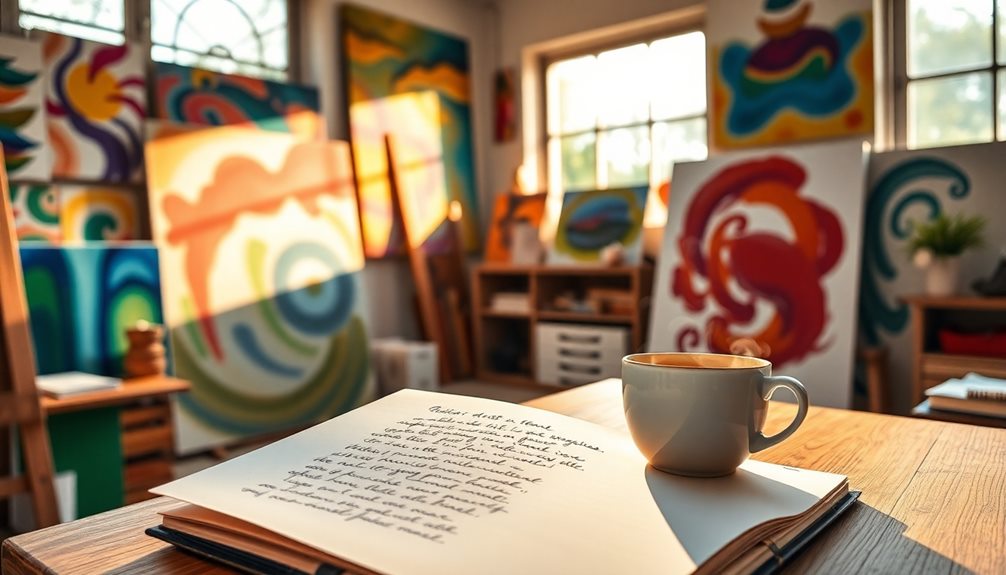When you explore artist statements, you get a glimpse into the thoughts and emotions fueling their work. These statements connect you with the artist, revealing their materials, techniques, and personal narratives. By articulating their intentions clearly, artists invite you to engage more deeply with their creations. Avoiding jargon and vague phrases allows for better understanding, making the statement accessible. Stories and personal experiences enrich the dialogue, helping you relate on a more profound level. You'll find that every artist's vision has unique layers worth uncovering, leading to a richer appreciation for their art and creativity.
Key Takeaways
- Artist statements should clarify the artist's intentions and creative processes, enhancing viewer understanding and engagement with the artwork.
- Effective statements use accessible language, avoiding jargon to ensure clarity for diverse audiences.
- Including specific details about materials and techniques showcases the uniqueness of the artist's work.
- Personal narratives can deepen connections, inviting viewers to relate emotionally to the artwork.
- Regular revisions based on feedback help keep statements relevant and aligned with the artist's evolving practices and goals.
Understanding Artist Statements

What makes an artist statement effective? An artist statement serves as an essential tool for connecting you, the artist, with your audience. It provides insight into your work, intentions, and creative processes, acting as a bridge that helps viewers understand your studio practice.
A compelling statement typically falls within 100 to 300 words, ensuring clarity and accessibility while steering clear of jargon and clichés.
To create an effective artist statement, focus on articulating the materials and techniques you use in your artwork. Highlight the unique narratives that shape your creations and connect your personal experiences to broader themes.
This not only adds depth to your statement but also enhances the viewer's appreciation of your work.
Importance of Artist Statements

Artist statements play a vital role in enhancing your connection with the audience by clarifying your artistic intentions.
They also open doors to professional opportunities, making them essential for exhibition submissions and grants.
Enhancing Audience Connection
While many might overlook the importance of artist statements, they play an essential role in fostering a connection between you and the artwork. A well-crafted artist statement acts as a significant communication tool, bridging the gap between your art practice and the audience. It offers insight into your intentions and motivations, enriching your viewer's experience.
When you articulate specific themes, concepts, and personal narratives, you invite the audience to dive deeper into the artwork. This engagement can transform their perception and appreciation, encouraging them to reflect on their interpretations and emotional responses. Your artist statement can prompt viewers to reflect on what resonates with them, fostering a more profound emotional connection.
Moreover, artist statements are often required for applications to exhibitions, grants, and residencies, making them essential for your professional opportunities and career advancement. By investing time in crafting a compelling statement, you enhance not only your audience's understanding but also your own practice.
Ultimately, a strong artist statement can elevate the dialogue around your work, allowing you to share your vision and invite others to join you on that journey.
Clarifying Artistic Intentions
A clear artist statement clarifies your intentions and helps viewers grasp the essence of your work. This crucial communication tool provides insight into your creative process, themes, and the ideas driving your art. By articulating your artistic intentions, you foster a deeper understanding and appreciation among your audience.
When they know what to look for, they can connect with your work on a more profound level.
A well-crafted artist statement is essential, especially when applying for residencies, grants, or exhibitions. These statements often serve as a bridge between you and potential opportunities, showcasing your unique practice.
To maximize impact, use clear and concise language, steering clear of jargon and clichés. This approach not only enhances engagement but also allows your audience to focus on your art's message.
Supporting Professional Opportunities
Many successful artists know that a strong artist statement can make all the difference when applying for professional opportunities. Often required for residencies, grants, and exhibitions, your artist statement is a key tool for articulating your practice and intentions. When you craft a well-written statement, you enhance your chances of success by providing insights into your creative identity and methodologies.
Your artist statement serves as a communication bridge between you and your audience. It enriches the viewer's understanding of your artwork, fostering connections that can lead to future opportunities. Remember, art organizations review thousands of statements annually, so a compelling statement helps you stand out in competitive fields.
Don't forget to update your artist statement regularly. As your artistic direction evolves, your statement should reflect those changes to remain relevant and impactful in professional contexts.
Crafting an Effective Statement

Crafting an effective artist statement is essential for communicating your vision and artistic intent to a wider audience. Keep your statement between 100 and 300 words to guarantee clarity and engagement. Use clear, direct language—avoid jargon to make it accessible to everyone.
Including specific details about the materials and techniques you use will help articulate what makes your work unique. Be sure to regularly revise your artist statement, ideally every year or six months, to reflect your evolving practice and current direction in making art since you started. Tailoring your statement for specific contexts, like grant applications or exhibitions, will enhance its relevance and effectiveness.
Here's a quick table to help you structure your artist statement effectively:
| Element | Description |
|---|---|
| Purpose | State your artistic intent clearly |
| Techniques | Describe materials and methods used |
| Personal Journey | Include your background and evolution |
| Audience Engagement | Consider who will read it and tailor accordingly |
| Revision & Updates | Schedule regular reviews to keep it current |
Common Mistakes to Avoid

When writing your artist statement, it's crucial to steer clear of common pitfalls that can undermine your message.
First, avoid using overly jargon-heavy language. Complicated terms can alienate readers who aren't familiar with art terminology, making it harder for them to connect with your work. Instead, aim for clarity that reflects your unique vision.
Remember, just like in building a business like software, prioritizing effective communication can enhance understanding and engagement with your audience.
You should also steer clear of vague or generalized statements. They fail to convey the specific qualities and intentions behind your artwork. Instead, focus on what makes your work distinctive and meaningful.
Resist the temptation to include clichéd expressions or tired phrases; these can dilute the originality of your statement. Remember, you want your voice to shine through.
Additionally, make sure that your statement doesn't confuse personal narratives with artistic concepts. Concentrate on the meaning and context of your artwork rather than your life story.
Engaging Your Audience

Engaging your audience is key to making your artist statement resonate. To achieve this, consider using storytelling techniques that foster emotional connections with your artwork and your journey as an artist. When you share personal anecdotes or highlight challenges, you invite viewers to relate to your experiences on a deeper level.
Posing thought-provoking questions within your artist statement can also spark contemplation and dialogue among viewers. These questions encourage them to reflect on the themes and emotions present in your work.
Additionally, incorporating visuals alongside your written content creates a multi-sensory experience, enhancing engagement and reinforcing your message.
Tailor the language and tone of your statement to suit your audience's background. Whether you're addressing casual viewers or art professionals, making your statement accessible and relatable can greatly improve its impact.
Revision and Feedback Process

When you revise your artist statement, taking breaks can give you fresh perspectives that sharpen your message. Engaging with diverse readers, from friends to strangers, helps you gather valuable feedback that can enhance your clarity and appeal.
Additionally, maintaining emotional alignment during this process can help you resonate more deeply with your audience, as seen in the importance of self-love in attracting ideal partners.
Plus, using iterative editing techniques guarantees your statement evolves alongside your artistic practice.
Importance of Fresh Perspectives
A fresh perspective is essential in refining your artist statement. Taking breaks between revisions helps you gain clarity on what you've written. When you step away, you return with new insights that can enhance the effectiveness of your message. Reading your statement aloud can also reveal awkward phrasing or unclear concepts that might not be obvious when reading silently.
Seeking feedback from a diverse group—friends who know your work and colleagues who don't—can provide valuable insights. Each person will highlight different areas needing improvement, ensuring a well-rounded critique. Consulting professionals or using coaching services can elevate your artist statement to a higher standard, helping you articulate your vision better.
Regularly revisiting and updating your artist statement keeps it relevant, reflecting your evolving practice and voice.
| Feedback Source | Benefits | Action to Take |
|---|---|---|
| Friends familiar with work | Understands context | Discuss and refine |
| Colleagues unfamiliar | Offers fresh insights | Gather their thoughts |
| Professionals | Provides expert critiques | Schedule a consultation |
| Reading aloud | Discovers phrasing issues | Edit for clarity |
| Breaks | Gains new insights | Step away periodically |
Engaging Diverse Readers
Incorporating diverse perspectives into the revision and feedback process can greatly enhance your artist statement. Engaging readers from various backgrounds helps guarantee clarity and resonance with a broader audience. When you seek feedback from friends, family, and mentors, you're opening the door to insights that reveal how effectively your statement communicates your intent and connects with different demographics.
Allowing sufficient time for feedback is essential. Avoid last-minute requests that can lead to superficial critiques. Instead, give your reviewers the space they need to offer thoughtful feedback that appreciably improves your statement's quality. Constructive criticism from individuals with diverse experiences can uncover blind spots you might've overlooked, strengthening your overall narrative.
Regularly revising and updating your statement based on this feedback keeps it relevant and reflects your evolving practice. The process fosters engagement with contemporary art discourse, ensuring your voice remains dynamic and relatable.
Iterative Editing Techniques
Iterative editing techniques are essential for refining your artist statement and guaranteeing it resonates with your audience. Start by taking breaks between revisions. This allows you to gain fresh perspectives, enabling clearer and more focused edits.
When you read your statement aloud, you'll identify awkward phrasing and guarantee the language flows naturally, which enhances overall readability.
Don't shy away from seeking feedback from a diverse group. Engage both familiar and unfamiliar audiences, as their insights can reveal areas needing clarity or improvement.
Creating a banned words list can also be beneficial. This practice discourages the use of overused phrases and clichés, helping maintain the originality and impact of your artist statement.
Resources for Assistance

How can you effectively convey your artistic vision? To craft a compelling artist statement, you can tap into various resources designed to assist you. Online workshops and courses are excellent starting points, offering expert guidance on articulating your vision and intent clearly.
Additionally, books and articles focused on artist statements provide valuable insights into best practices and common pitfalls to avoid. Engaging with philosophical exploration can also enhance your understanding of authenticity in your artistic expression.
Consider joining peer feedback and critique groups, where you can receive diverse perspectives and constructive criticism that can refine your statement. Templates and examples from established artists can also serve as a helpful framework, allowing you to structure your statement while maintaining your unique voice.
Don't overlook the support offered by art organizations, which often provide resources specifically aimed at assisting artists with developing their statements. This can enhance your professional opportunities and visibility in the art community.
Evolution of Artist Statements

Over the years, artist statements have transformed considerably, reflecting changes in both the art world and broader cultural contexts. Initially, these statements were formal, authoritative texts rooted in the late 19th and early 20th-century manifestos. Today, they emphasize personal narratives and unique perspectives.
As museums and galleries shift towards audience engagement, artist statements have become essential for connection and understanding. This evolution has embraced storytelling, allowing you to share your artistic journey in ways that resonate with diverse audiences. Digital platforms further expand your reach, presenting your work and thoughts to a wider audience than ever before.
Incorporating inclusivity and acknowledging diverse cultural backgrounds has also shaped how artist statements are crafted. By reflecting on your context, you contribute to a richer dialogue in the art world.
| Traditional Statements | Contemporary Statements | Impact on Audience |
|---|---|---|
| Formal and authoritative | Personal and conversational | Greater engagement |
| Focused on technique | Emphasizes storytelling | Enhanced connection |
| Static and limited reach | Dynamic and accessible | Broader understanding |
These shifts guarantee that artist statements not only convey your intent but also invite others into your artistic world.
Frequently Asked Questions
How Long Should an Artist Statement Be?
An artist statement should typically be concise, around 250 to 500 words. You want it to be engaging yet informative, so focus on clarity and impact without overwhelming your audience with unnecessary details.
Can I Include Personal Anecdotes in My Statement?
Absolutely, you can include personal anecdotes in your statement. They can make your work more relatable and provide insight into your creative journey. Just guarantee they enhance your message without overshadowing your main ideas.
Should I Use Technical Jargon in My Statement?
Using technical jargon in your statement can confuse readers. Instead, focus on clear, accessible language that conveys your ideas effectively. You want your message to resonate, so keep it simple and relatable for everyone.
How Often Should I Update My Artist Statement?
You should update your artist statement regularly, especially after major exhibitions, new works, or shifts in your artistic focus. Keeping it fresh guarantees it accurately reflects your evolving practice and engages your audience effectively.
Is It Necessary to Write a Statement for Every Artwork?
Imagine each artwork as a bird. You don't need a unique song for every flight, but a statement can help your audience understand its journey. So, it's not always necessary, but it can enhance appreciation.
Conclusion
In crafting your artist statement, remember it's your chance to connect with your audience and share your vision. For instance, consider a hypothetical painter who initially wrote a dry, technical statement. After revisions and feedback, they transformed it into a vivid narrative about their journey through color and emotion, enchanting viewers and collectors alike. By actively engaging with your audience, your statement can become a powerful tool that elevates your art and resonates on a deeper level.









